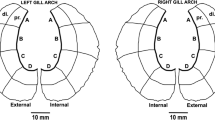Abstract
This paper describes experimental work on parasite specificity in the copepod-procercoid system of Bothriocephalus claviceps. Two criteria were used to characterize five potential host species Macrocyclops albidus, Macrocyclops fuscus, Eucyclops serrulatus, Acanthocyclops robustus and Macrocyclops viridis viridis. The first criterion involves susceptibility of the copepods to infection. The results show random or aggregative distributions and variable susceptibilities according to the species. We observed an ethological barrier to infection in M. viridis viridis and M. fuscus. The second criterion involves the growth and development of the procercoid. Three factors modify the profiles of the growth curves: host species, sex and intensity of infection. The growth of the procercoids is density-dependent, whereas their development is independent of density.
This last characteristic is interpreted as a factor favouring the aggregation of procercoid populations. The two most susceptible hosts are M. albidus and A. robustus.
Similar content being viewed by others
References
Clarke AS (1953) Studies on the life cycle of the Pseudophyllidean Cestode Schistocephalus solidus. Proc Zool Soc Lond 124:257–302
Dupont F (1984) Biologie des populations de Bothriocephalus claviceps Cestode Pseudophyllidea parasite de l'Anguille européenne. Thèse de 3ℴ cycle, USTL, 199 pp
Dupont F, Gabrion C (1986) Dynamique de populations de Bothriocephalus claviceps (Cestoda, Pseudophyllidea), parasite de l'Anguille Anguilla anguilla en Camargue. Vie Milieu (in press)
Elliott JM (1983) Some methods for the statistical analysis of samples of benthic invertebrates. Freshwater Biological Association, Scientific Publication nℴ 25: 156 pp
Guttowa A (1956) Prove (sic) of experimental definition of the main first intermediate hosts of broad fish tapeworm Diphyllobothrium latum (L.) in the area of Poland. Acta Parasitol Pol 4:781–802
Guttowa A (1961a) Experimental investigations on the systems “procercoids of Diphyllobothrium latum (L.) — Copepoda”. Acta Parasitol Pol 9:371–408
Guttowa A (1961b) Potential intermediate host (Copepoda) of the broad tapeworm of man Diphyllobothrium latum (L.) in Norway. Nytt Mag Zool 10:57–62
Halvorsen O (1966) Studies of the helminth fauna of Norway VIII: an experimental investigation of copepods as first intermediate hosts for Diphyllobothrium norvegicum Vik (Cestoda). Nytt Mag Zool 13:83–117
Halvorsen O (1976) Negative interaction amongst parasites in Ecological Aspects of Parasitology. North-Holland Publishing Company, Kennedy CR (ed), Amsterdam, Oxford, pp 99–114
Jarecka L (1959) On the life-cycle of Bothriocephalus claviceps (Goeze 1782). Acta Parasitol Pol 7:527–533
Jarecka L (1964) Cycle évolutif à un seul hÔte intermédiaire chez Bothriocephalus claviceps (Goeze 1782) Cestode de Anguilla anguilla (L.). Annls Parasit Hum Comp 30:149–156
Jarroll EL (1979) Population biology of Bothriocephalus rarus Thomas (1937) in the red-spotted newt, Notophthalmus viridescens Rat. Parasitology 79:183–193
Meyer MC, Vik R (1963) The life cycle of Diphyllobothrium sebago (Ward 1910). J Parasitol 49:962–968
Michajlow W (1932) Les adaptations graduelles des Copépodes comme premiers hÔtes intermédiaires de Triaenophorus nodulosus Pall. Ann Parasit Hum Comp 10:334–344
Michajlow W (1953) The intraspecies relationships in the procercoid populations of Triaenophorus lucii (Müll). Acta Parasitol Pol 1:2–28
Michajlow W (1963) Results of experimental infecting of Copepoda from Hansersee (Switzerland) with the larvae of Diphyllobothrium latum (L.) (Cestoda). Bull Ac Pol Sci 11:347–351
Miller RB (1943) Studies on cestodes of the genus Triaenophorus from fish of Lesser Slave Lake, Alberta. II. The eggs, coracidia and life in the first intermediate host of Triaenophorus crassus Ford and T. nodulosus (Pallas). Can J Res D 21:284–291
Rosen F (1918) Recherches sur le développement des Cestodes. I. Le cycle évolutif des Bothriocéphales. Essai sur l'origine des Cestodes et leurs états larvaires. Bull Soc Neuchateloise Sc Nat 43:1–64
Rosen R, Dick TA (1983) Development and infectivity of the procercoid of Triaenophorus crassus Forel. and mortality of the first intermediate host. Can J Zool 61:2120–2128
Thomas LJ (1937) Environmental relations and life history of the tapeworm Bothriocephalus rarus (Thomas 1937). J Parasitol 23:133–152
Watson NHF, Lawler CH (1965) Natural infections of Cyclopoid copepods with procercoids of Triaenophorus spp. J Fish Res Bd Canada 22:1335–1343
Watson NHF, Price JL (1960) Experimental infections of Cyclopoid copepods with Triaenophorus crassus Ford. and T. nodulosus (Pallas). Can J Zool 38:345–356
Author information
Authors and Affiliations
Rights and permissions
About this article
Cite this article
Dupont, F., Gabrion, C. The concept of specificity in the procercoid-copepod system: Bothriocephalus claviceps (Cestoda) a parasite of the eel (Anguilla anguilla). Parasitol Res 73, 151–158 (1987). https://doi.org/10.1007/BF00536472
Accepted:
Issue Date:
DOI: https://doi.org/10.1007/BF00536472



